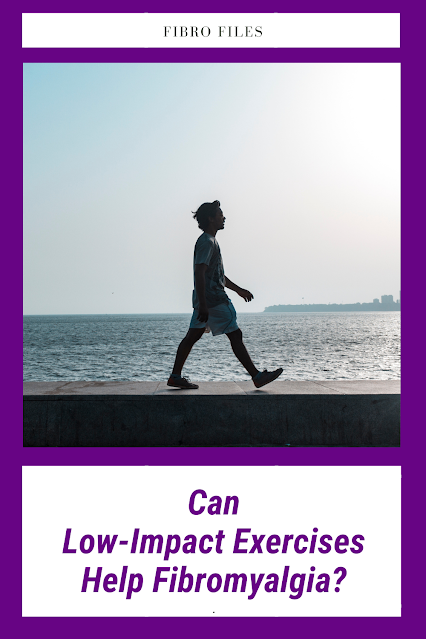Getting it just right for the individual living with chronic pain is an issue. Many people believe you should push through the pain and do exercise and many people with fibro find this ridiculous.
I believe the kind of exercise you do when you live with chronic pain is crucial.
The other thing that is important is your current situation... are you bed-ridden, living in a wheel-chair, able to walk around easily or walking with the help of a cane?
Low-impact exercises have definitely been shown to improve symptoms of fibromyalgia in different studies. It can lessen pain and improve fitness. A 2007 study found that women with fibromyalgia in a four-month exercise program reported significant improvements in physical function, fatigue, and depression.
But don't overdo it. Walking, stretching, and water WALKING are good things to start with.
Low-impact means that the impact on our joints, especially our knee, ankles and hips is reduced. Some helpful low-impact exercises include:
Yoga and Tai chi:
Yoga and tai chi are practices that combine meditation, slow movements, deep breathing and relaxation. Both have been found to be helpful in controlling fibromyalgia symptoms.
A study by Oregon Health and Science University has confirmed that yoga is of benefit to fibro sufferers.
A study published in 2018 found that tai chi was helpful and recommended in reducing fibromyalgia symptoms.
Pilates:
Significant improvement was observed in both pain and Fibromyalgia Impact Questionaire after 12 weeks of Pilates exercises according to this study.
Walking:
The Mayo Clinic lists walking as the number one form of exercise for fibromyalgia. Walking can decrease your pain and stiffness.
Start off slowly, for example, with 10-minute walks. Then build up your time.
Gentle water aerobics and Hydrotherapy:
Warm water can be relaxing to muscles and joints and the water supports your body making exercise easier.
Aquatic training is beneficial for improving wellness, symptoms, and fitness in adults with fibromyalgia according to this systematic review.
Exercise can reduce stress and relieve muscle tension and pain. It can improve your range of motion and flexibility. It can restore muscle strength or prevent it from deteriorating. It increases serotonin in the brain which makes us feel calmer.
So why don't we exercise? It's like a catch 22 situation where exercise can make us feel better on so many levels but we actually have to feel good, or at least okay, to want to get up off the lounge and exercise.
I have been exercising again, after a break, and I feel so much better. It's not just that it gives structure to my week but I actually feel better: less pain and stronger arm muscles. Before it killed me to carry the groceries in from the car and now I can actually manage. So that is a big improvement.
It wasn't easy to get started with exercise, I really had to force myself. I made it like an appointment I had to keep and just stuck to it and now I really look forward to it and thoroughly enjoy it…nothing too vigorous just gentle walking three days a week, hydrotherapy one day and exercises recommended by the physiotherapist on the other three days.
The thing I have found important is to start very slowly with whatever exercise I try and build up slowly. I've been a very active person in my past and learning to go slow at the start and realize I am no longer that same person has been a huge learning curve for me.
Do you manage to fit exercise into your life? Do you have any handy hints for getting moving?
Maybe you already exercise and want to take it up a notch. If so, reading Kim's inspiring story may help.
This post was LINKED UP AT FIBRO FRIDAY
SOURCES:
Archives of Internal Medicine. Nov. 12, 2007;167(20):2192-200.
http://www.ncbi.nlm.nih.gov/pubmed/17998491
Altan L, Korkmaz N, Bingol U, Gunay B. Effect of Pilates training on people with fibromyalgia syndrome: a pilot study. Arch Phys Med Rehabil. 2009;90:1983–8. doi: 10.1016/j.apmr.2009.06.021.
Aquatic exercise training for fibromyalgia.
Bidonde J, Busch AJ, Webber SC, Schachter CL, Danyliw A, Overend TJ, Richards RS, Rader T.Cochrane Database Syst Rev. 2014 Oct 28; (10):CD011336. Epub 2014 Oct 28.


Thanks for sharing. I try to do yoga when I get a chance, but it seems like a get going with it then get distracted by work, kids, and life in general and never keep up with my yoga. Thanks though for reminding me to stick with it!
ReplyDeleteAs women I think we can be so easily distracted by all the things that life puts in front of us. Some people even say that The "people pleasing" personality (for want of a better expression) is the one seen in many people with fibromyalgia! hope you can find 10 minutes a day for you and yoga which I guess is better than nothing.
Delete